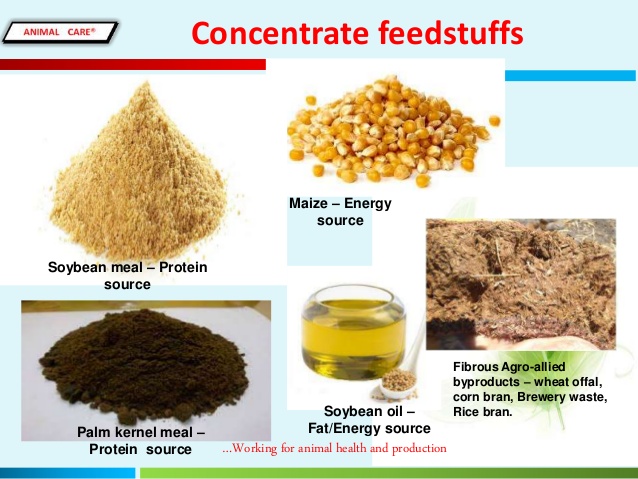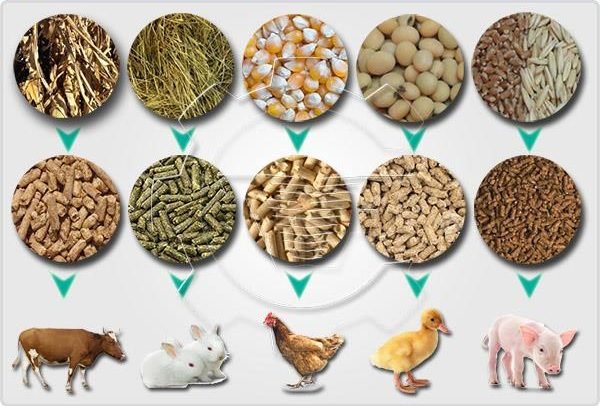Back to: AGRICULTURAL SCIENCE SS2
Welcome to Class !!
We are eager to have you join us !!
In today’s Agricultural Science class, We will be learning about Animal Nutrition. We hope you enjoy the class!

CONTENT
- Meaning of Animal Nutrition
- Classification of livestock feeds
- Food Nutrients of livestock
MEANING OF ANIMAL NUTRITION
Animal nutrition is the process by which an animal obtains nutrient necessary for its healthy growth and development.
IMPORTANCE OF ANIMAL FEEDS
- Animal feeds are needed for growth
- Useful for repair or worn out tissue
- It provides energy
- It is useful for the general well-being of the animal.
- It aids the animal’s resistance to diseases.
- It influences maturity in animals.
- It aids optimal production in animals.
DEFINITION OF FEED
Feed refers to the food given to animals. They contain nutrient element either alone or in combination with other substances which supports the healthy growth and development of livestock.
CLASSIFICATION OF LIVESTOCK FEEDS
Animal feeds can be classified into four main groups according to the digestibility, quantity of fibre, quantity required and moisture in the feed. The four groups of feeds are;
- Concentrates: They are fee with a low proportion of fibre and water content. They are easily digested by farm animals. Concentrates can be further be subdivided into two groups: Those containing a high proportion of carbohydrates are called carbohydrate concentrates/basal feed/energy feed e.g. maize, guinea corn, cassava etc. while those with a high proportion of proteins are called protein concentrate e.g. beans, peas, cottonseed, sunflower seeds and heads, groundnuts, palm kernel and animal products such as meat, blood meal, bone meal, fishmeal and milk.
- Roughages: Roughages are very low in protein and carbohydrate but high in fibre. They are not easily digested by animals, therefore are fed together with concentrate foods for young animals and those kept for milk and meat production. Examples are hay, groundnut hulls, straw, bean pods and maize stover.
- Succulents: These have high water content. They are easy to digest. Examples are freshly cut/lush grass and legume plants (soilage), pumpkin, silage, melons and most green crops.
- Supplements (minerals and vitamins): they are required in small quantities, low in energy, protein and fibre but high in vitamins and minerals. They aid digestion and increase animals resistance to diseases. They are available in basal and protein concentrate feeds. Other sources are bone meal, oyster shell, salt licks etc.

- Basal/Energy Feed or Carbohydrate Concentrates
Characteristics
- They are fed with crude fibre content less than 18%
- They are high in energy and starchy food e.g. maize and cassava
- It is high in carbohydrates or fats
- It is low in proteins
- Low in fibre
- It is highly digestible
- It is low in minerals
2. Protein Concentrate
Characteristics
- The crude fibre content is less than18%
- Protein concentrate is high in protein
- They are low in carbohydrates and fats
- They are low in fibre
- They are highly digestible
- They are low in minerals
3. Mineral and Vitamin Supplements
Characteristics
- They are required in small quantities in feeds
- They supplement basal and protein concentrates
- They are low in energy
- Low in protein
- Low in fibre
- High in vitamin and minerals
- Necessary for growth and development
- They aid food digestion
- They aid resistance to diseases
4. Roughages
Characteristics
- They are feeds which contain crude fibre that is greater than 18%
- They are high in fibre
- They are low in digestible carbohydrates
- They are low in protein
- They have poor or low digestibility
- Pasture grasses and legumes form roughages
- Roughages exist in different forms which are; hay, straw, soilage and salvage.
5. Hay: It refers to the aerial part of a young and succulent grass or herbage cut and dried for feeding animals
6. Straw: This is the aerial part of grass or harvested crops cut and store for future use. They are difficult to digest. Both hay and straw are called dry roughages
7. Soilage: This refers to the process of cutting fresh or succulent grass or legumes from the field and taking them to the animals in their pens. It is also called zero grazing
Silage: This refers to the preservation of green and succulent forage crops under anaerobic condition.
ACTIVITY
Describe the preparation of silage.
EVALUATION
- What is animal nutrition?
- State the classes of animal feed
ANIMAL FEED INGREDIENTS
These are the raw materials used in the production of animal feeds. These include; blood meal, fish meal, groundnut cake, palm kernel cake, cottonseed meal, bone meal, maize, guinea corn etc.

ACTIVITY
Explain the method of preparing the ingredients mentioned above.
FOOD NUTRIENTS OF LIVESTOCK

There are six classes of food nutrients. These are;
- CARBOHYDRATE: It is made up of carbon, hydrogen and oxygen.
Sources: Maize, guinea corn, cassava, grasses, wheat, potato, rice, millet, yam, hay, silage, potato, rice millet, yam, hay, silage potatoes etc
FUNCTIONS OF CARBOHYDRATES
Provides energy to farm animal for growth, reproduction, milk production and other activities.
- PROTEIN: It is composed of carbon, hydrogen, oxygen and sometimes sulphur, nitrogen and phosphorus
Sources: The sources of animal proteins are; fish meal, blood meal, meat meal, milk, earthworms, eggs, etc. Plant proteins sources are; soya beans meal, groundnut cake, palm kernel cake, cottonseed meal, sunflower seed meal, cashew nut meal and leguminous forage. Synthetic sources of proteins are; methionine, lysine, cysteine
FUNCTIONS OF PROTEIN
- Essential for the growth of young animal tissue
- They are used to repair worn-out tissue
- They are used in the formation of gametes in reproduction
- They are needed for the production of enzymes
- They are necessary for flesh built-up
- Essential for the sustenance of life
- Help to provide raw materials for building protective covering such as hair, nails roof, wool feather etc.
- FATS AND OIL
Fat is composed of carbon, hydrogen, and oxygen
Sources: These are palm oil, palm kernel cake, groundnut cake, coconut meal, cottonseed cake, milk, lard and fallow.
FUNCTIONS OF FATS AND OIL
- Fats provide more energy than carbohydrates
- Fat supply essential fatty acids and fat build-up
- They provide fat-soluble vitamins
- They improve the diet
- They help in the maintenance of body temperature
4. MINERALS: these are essential elements needed by the body but which the body cannot produce. They are grouped into two major classes:
- Structural mineral elements: Carbon, Hydrogen, Oxygen and Nitrogen
- Mineral elements are further divided into
A) Macro-elements or mineral: These are required by animals in large quantity e.g. calcium, phosphorus, magnesium, potassium, sulphur, sodium and chlorine
B) Trace Elements or microelements: These are required by animals in small quantity e.g. iodine, cobalt, copper, manganese, zinc and fluorine.
Sources are born meal, oyster shell, limestone and salt licks
FUNCTIONS OF MINERAL
- It helps to ensure good health and productivity
- Present in muscles for muscle contractions
- A constituent of milk, egg and meat
- Help in the formation of hormones.
- Maintain the PH balance of body fluids
- They prevent diseases
- Regulate blood clotting
- Help in bone and teeth formation
- Prevent tooth decay
| MINERALS | SOURCES | FUNCTIONS | DEFICIENCY SYMPTOMS |
| Calcium | Bone meal, oyster shell, limestone, milk rock calcium phosphate | Bone and teeth formation Eggshell formation Blood clotting | Ricket, osteomalacia, soft eggshell. Retarded growth |
| Phosphorus | Bone meal, Dicalcium phosphate, fish meal | Bone and teeth formation; Acid-base balance; Eggshell formation | Ricket, Lack of appetite. Osteomalacia |
| Magnesium | Salt licks, wheat germs, forage, grasses | Aid functioning of the nervous system. Activation of enzymes | Hyper-irritability, Nervous disorder Called tetany |
| Sodium and Chlorine | Common salt, salt licks, fish meal | Regulates acid-base balance; Maintenance of osmotic pressure, constituents of Hcl Improves the pleasant taste of feed. | Reduced growth and weight; decline in appetite.
|
| Sulphur | Salt licks, fish meal | A constituent of protein and amino acids like cysteine, methionine | Poor growth |
| Iron | Yeast, iron injection, salt licks | A constituent of haemoglobin in the red blood cell. A constituent of a protein called myoglobin | Anaemia e.g. baby pig anaemia of piglets. |
| Iodine | Iodined salts, fish meal | A constituent of a hormone called thyroxine | Goitre |
| Cobalt | Salt licks Activate some enzymes | Constituents of vitamins B12 | General malnutrition |
| Copper | Salt licks | Aids formation of haemoglobin & Iron absorption | Anaemia |
| Fluorine | Salt licks, fluorinated water | Prevents tooth decay | Tooth decay. |
To be Continued, next class
We have come to the end of this class. We do hope you enjoyed the class?
Should you have any further question, feel free to ask in the comment section below and trust us to respond as soon as possible.
In our next class, we will continue learning about Animal Nutrition. We are very much eager to meet you there.

very helpful, thanks a lot
tnx alot for helping education
We’re glad you found it helpful😊 For even more class notes, engaging videos, and homework assistance, just download our Mobile App at https://play.google.com/store/apps/details?id=com.afrilearn. It’s packed with resources to help you succeed🌟
tnx for helping education
We’re glad you found it helpful😊 For even more class notes, engaging videos, and homework assistance, just download our Mobile App at https://play.google.com/store/apps/details?id=com.afrilearn. It’s packed with resources to help you succeed🌟
very good helps a lot
This was more than I expected!
Thanks a lot
very helpful 😁😃😏😌😊🙋